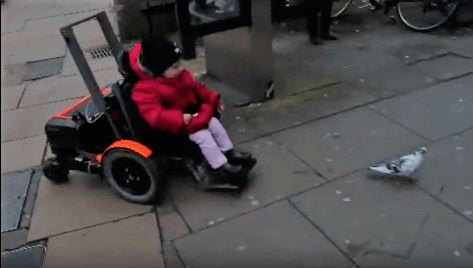
Some years ago, just after I had presented an academic paper on early mobility at an international symposium, a well-respected researcher accosted me, wide-eyed and excited: “Where did you get all that data about disabled children’s development?”. I had to tactfully admit that, as disabled children are also human children, the key source for a lot of my paper’s data had been my GCSE Child Development textbook…
For a girl heading for a career in corporate finance law, and with the (still not quite abandoned) intention of getting an MBA, a GCSE in Child Development was not the obvious choice. But in the work I do now it has been more useful to me than the second foreign language, or the triple science award, could ever have been.
Possibly because I was myself a child in powered mobility, I have been able to see past the novelty of a toddler in control of a chair (“Babies Drive Robots” is my favourite tabloid-esque, clickbait headline). Instead I can connect the mobility with the normal developmental milestones that every child needs to access.
As well as the infinite variety of small behaviours that a toddler can and must go through for their development such as (to name but a few):
- Pulling pans out from the kitchen cupboard (hand-eye coordination, understanding sound, the beginnings of engaging in family tasks);
- Touching the radiator, and learning not to touch it (sensory development, discipline, cause and effect);
- Posting the gas bill down the back of the fridge (fine motor skills, shape, responsibility),
there are a few major and significant landmarks in development which indicate that a child is grappling with, and mastering, big intellectual leaps.
My favourite of these, at first glance sounds fairly minor, but it’s huge! It is going to the window to wait for someone who is expected. Often it will be Daddy coming home from work. Think about it from the mind of a little person who is figuring out how the world works…
First of all, our toddler has comprehended that Daddy exists even when we cannot see him. You, an adult, think this is a given; but it was news to you once, too! Earlier in brain development, a baby only believes in people they can see. Once we’ve grasped the new concept, we consolidate it by acting on it.
By trying out the ‘Daddy is somewhere else’ hypothesis, this little brain can build on it to reach the conclusion that ‘somewhere else’ is connected to where we are now. Daddy will come into view on the driveway before he comes through the front door. First, our toddler supposes that the space outside the window is always connected to the space inside. Daddy always comes around the same corner, so the next piece of the jigsaw is that wherever he comes from is always attached where we cannot see. Now the imagination can conjure a ‘somewhere else’ place, even though we have never seen it. We’re getting truly existential here, but these are all concepts that adults know and use, that they didn’t have when they were born.
Next: outside and inside are separated by the window, and we can see through the window even though when we touch it it feels solid. When you haven’t seen the phenomenon before, transparent things are weird. Try it now – look through a window. Everything looks the same but different, right? You, who have been looking through windows your whole life, can tell the difference. Before you were two years old, you worked this out.
And here’s another thing that you now take as given, that you once learned: the progress of time. Our toddler has wanted Daddy to come home since breakfast-time. We have been to play at Tiny Toes, napped, had lunch, been to the shops, picked up the older kids from school, but it’s not until after we’ve watched Furchester and eaten tea that it is worth looking out for Daddy. He will be home before bedtime. After, before, since, until, breakfast-time, bedtime – these are concepts that we learn to understand through experience.
Going to look out of the window is not just the indicator that your toddler has reached all these cognitive milestones – it is how they consolidate the thought processes. And tiny humans, even the disabled ones, learn like every other human. “Tell me, I forget, show me, I remember, involve me, I understand.”
